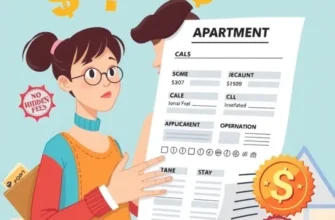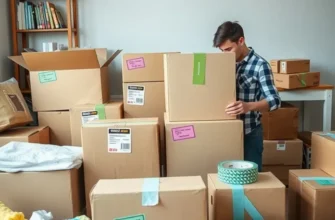The thought of renting a home remotely might conjure images of stressful calls and blurry photographs, but let’s face it—you’re not alone! Whether you’re a young professional seeking a fresh start in a vibrant city, a couple ready to cozy up in a new neighborhood, or a family craving space for the kids and pets, renting from a distance is entirely doable. The digital age has bestowed upon us tools to make this leap with confidence. So, toss those worries aside! We’ll guide you through the maze of online listings, video tours, and the ever-important application process. With a little humor, a pinch of practicality, and some straightforward advice, you’ll see that securing your new pad is just a click away!
Finding Your Perfect Long-Distance Rental

Embarking on the search for a long-distance rental can be daunting. Fortunately, there are effective strategies to streamline the process. From the right websites to virtual tours, we cover the essential steps to uncover your next home from afar.
First, choose reliable websites designed for rental searches. Opt for platforms that specialize in rental properties rather than general real estate. This helps narrow your focus to genuine rental listings, minimizing time spent on unsuitable options.
Next, evaluating neighborhoods from a distance is crucial. Don’t limit your research to rental listings. Dive into community forums and social media groups focusing on specific areas. These resources offer valuable insights into local vibes, amenities, and ongoing developments that may not be reflected in property descriptions.
Safety should be a top priority when selecting a neighborhood. Look for online crime maps and local police department resources. Many cities publish annual safety reports, summarizing crime rates and types. Such data allows you to gauge neighborhood safety without being physically present.
Virtual tours have become a game-changer, allowing renters to explore potential homes from their current location. A virtual tour provides a realistic view of the property’s layout, condition, and features. Remember to assess the fit for your lifestyle and any furnishings you intend to bring along.
Leverage technology to get a better peek at the kind of home you’re settling for. Examine high-resolution photos alongside virtual tours to note any discrepancies. Photos can sometimes omit flaws, which is why virtual tours are essential to understand spatial arrangements.
If possible, ask the property manager or landlord for a live virtual walkthrough. A live session can address immediate queries, provide a clearer picture, and even negotiate terms. Remember, clear communication is key to expressing your needs and desires throughout this process.
For those contemplating a move to bustling cities like Charleston, SC, consider tapping into local guides that outline the best areas for renting. Understanding the rental landscape through localized resources can inform your decision and help pinpoint options that align with your priorities. Learn more about renting in specific cities here.
Finally, never underestimate the potential for scams. Verify that listings come from reputable sources and check the rental’s legitimacy. Avoid properties that require large deposits or rent payments before signing a lease. Look for reviews or testimonials from previous tenants to back up any claims made by the landlord.
Following these guidelines will ease the long-distance rental search, bringing you closer to finding a comfortable and enjoyable home.
Navigating the Rental Application Process

Applying for a rental property from afar might seem daunting, but with the right approach, you can make it a seamless experience. Here’s a detailed guide to help you navigate the rental application process, ensuring you cover all bases without being physically present.
Start by thoroughly reviewing the rental listing and landlord’s requirements. Each property might have its own set of criteria, including income level, pet policies, and specific leasing terms. Compile a digital folder with all necessary documents. These typically include a copy of your ID, recent pay stubs, bank statements, and any previous rental references. A comprehensive package can expedite the process and demonstrate your seriousness as a tenant.
Background checks are a common practice in the rental market. They allow landlords to verify your rental history, credit score, and criminal record. Before applying, obtain your own credit report to identify and resolve discrepancies. Renter credit improvement tips can be a useful resource if you wish to enhance your score pre-application.
At times, your credit score or income might not meet the landlord’s requirements. In such cases, a co-signer can provide the assurance landlords need. A trusted family member or friend who meets the financial criteria can act as a guarantor. Prepare them by explaining their responsibility and how it impacts their credit, ensuring they’re comfortable with this commitment.
Effective communication with potential landlords is key. Introduce yourself with a well-composed email or phone call, expressing genuine interest in the property. Clarify your timeline, availability for a virtual tour, and any queries related to the lease. This proactive approach not only showcases your interest but also helps build a positive rapport.
Virtual tours are an essential tool for long-distance renting. Book a session to walk through the property with the landlord or property manager. It’s an opportunity to ask questions about the neighborhood, amenities, and maintenance procedures. A clear understanding of these aspects helps in making an informed decision.
Once you’ve submitted your application and undergone the necessary checks, patience becomes essential. While you wait for a response, avoid applying to multiple properties at once, which can strain your finances with repeated application fees. However, always keep an alternative option or two in mind to prevent potential last-minute scrambles.
Upon approval, carefully review the lease agreement. Consider consulting with a legal advisor if any terms are unclear. Pay attention to clauses about late fees, repair responsibilities, and subletting rules. A well-negotiated lease will save you from future headaches and ensure a pleasant renting experience.
Navigating the rental application process remotely requires organization, clear communication, and a proactive mindset. With these steps, you can confidently secure a rental property, no matter the distance.
Final words
Renting from long-distance can feel intimidating at first. However, with the right approach and resources, you’ll discover that it’s perfectly manageable. Keep your eyes peeled for reliable listings, don’t skip out on virtual tours, and maintain clear communication with potential landlords. Pack your excitement and maybe a couple of humorous anecdotes because pretty soon, you’ll be moving into your new home, ready for fresh adventures. Happy hunting, future renters!









